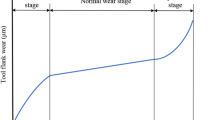Abstract
A monitoring of tool wear in different cutting operations has been studied for many years. Special techniques have been used to detect a wear status basing upon cutting forces, acoustic emission, temperature, torque and power, vibration, noise and acceleration sensors. The adapting of a proper prediction method allows to solve problems of an automatic supervision in Computer Integrated Manufacturing systems. A task of the abrasive edge wear index prediction can be formulated as follows: disposing by the data collection of the edge wear status in a time period preceding the concerning the wear status in the successive time period embraced by the prediction method.
Zusammenfassung
Die Überwachung des Werkzeugverschleißes wurde im Rahmen umfassender Forschungsprojekte untersucht. Spezielle Prüfmethoden wurden zur Bestimmung des Verschleißgrades angewendet, wobei Zerspanungskraft, akustische Emission, Temperatur, Drehmoment, Zerspanungsleistung, Schwingungen, Schallund Beschleunigungs-Sensoren die Basis bildeten. Durch sinnvolle Anpassung theoretischer Überlegungen werden die Probleme der Überwachung im Rahmen des Computer Integrated Manufacturing einer Lösung zegeführt. Der Vorhersageindex des abrasiven Kantenverschleißes kann folgendermaßen formuliert werden: Eliminierung des Datensatzes des Grades des Kantenverschleißes in einer vorgegebenen Zeit, bevor man sich mit dem Abnützungsgrad im nachfolgenden Zeitabschnitt auseinandersetzt. Dadurch kann ein Ansatz für eine grundsätzliche Vorhersagemethode gefunden werden.
Similar content being viewed by others
References
Brown, R. G., Mayer, R. F.: The fundamental theorem of exponential smooting. Operations Research (1961), Vol. 5.
Carlsson, T. E., Strand, F.: A statistical model for prediction of tool life as a basis for economical optimization of the cutting process. Annals of the CIRP 41 (1992), 1, pp. 79–82.
Eman, K. F., Wu, S. M.: A feasibility study of on-line identification of chatter in turning operations. Journal of Eng. for Industry 102 (1980), pp. 315–321.
Gawlik, J.: Prognozowanie stanu zuzycia ostrzy narzçedzi w procesie skrawania. Monografia 66. Kraków 1988.
Gawlik, J., Harasymowicz, J., Zębala, W.: The method of the minimum thickness of cutting layer identification in the precision cutting. Intern computer science conference “microCAD’95”, Miskolc, 1995, pp. 28–33. Conference Press.
Gawlik, J., Płaza, M.: Adaptacyjne sterowanie intensywnością zużycia ostrzy narzędzi w zautomatyzowanych, samouczących się układach obróbkowych. Prace Naukowe Instytutu Cybernetyki Technicznej Politechniki Wrocławskiej (1988), Nr. 77, pp. 35–41.
Gawlik, J., Zębala, W.: Die Bedingungen zum Erreichen minimaler Spannungsdicken. VIII. Internationale Werkzeugkonferenz, Miskolc, 1993, S. 527–531. Conference Press.
Goller, J. A., Barrow, G.: The prediction of surface finish in turning operations. Thirty-first international matador conference, Manchester, 20th–21st April 1995, pp. 229–347. Conference Press.
Katalinic, B.: Intelligent manufacturing systems. 6th International symposium DAAAM’95, Kraków 1995, pp. 165–166.
Merchant, E.: World trends in advanced manufacturing technology. Conference on advanced technology in design and manufacturing, II Congreso Mundial Vasco, Bilbao, 1966, Conference Press.
Shirakashi, T.: New trend on machining theory. Int. J. Japan Soc. Prec. Eng. 27 (Dec. 1993), No. 4, pp. 299–301.
Si, L., Osanna, P. H.: Intelligent production systems in MFIF. 6th International symposium DAAAM’95, Kraków, 1995, pp. 305–306.
Tae Jo Ko, Dong Woo Cho: Fuzzy pattern recognition for tool wear monitoring in diamond turning. Annals of the CIRP 41 (1992), 1, pp. 125–128.
Young Hong-Tsu, Mathew, P., Oxley, P. L. B.: Prediction cutting forces in face milling. Int. J. Mach. Tools Manufact. 34 (1994), No. 6, pp. 771–783.
Zębala, W.: Theoretical and experimental identification of minimal thickness of cutting layer for aluminum alloys. Doctor’s Thesis at Production Engineering Institute of Technical University of Cracow, Kraków, 1994.
Author information
Authors and Affiliations
Additional information
Nach einem Vortrag, gehalten anläßlich des vom 17. bis 19. Oktober 1996 in Wien veranstalteten 7. Intermationalen DAAAM-Symposiums.
Rights and permissions
About this article
Cite this article
Gawlik, J., Zçebala, W. The strategy of edge wear prediction in CIM concept. Elektrotech. Inftech. 114, 191–194 (1997). https://doi.org/10.1007/BF03158660
Issue Date:
DOI: https://doi.org/10.1007/BF03158660




